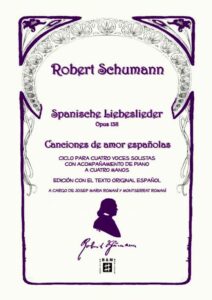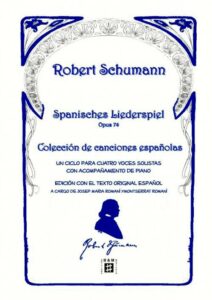Edición especial de 2 ciclos de lieder de Robert Schumann
El pasado 8 de junio (2020), se celebró
el 210 aniversario del nacimiento del gran compositor alemán Robert Schumann
(1810 – 1856), y queremos participar de esta conmemoración con la publicación
de 2 de sus ciclos de lieder, en una edición muy especial.
Se trata de los ciclos Spanisches Liederspiel op. 74 y Spanische Liebeslieder op. 138, en una edición con los textos originales en español de los poemas del s. XV y XVI que Schumann utilizó traducidos al alemán por Emmanuel Geibel en el volumen Volkslieder und Romanzen der Spanien, publicado en 1843.
Esta labor de adaptación de
muchos años ha sido llevada a cabo por Gemma Gorga (Doctora en Filología
Hispánica y profesora de la Universidad de Barcelona), el musicólogo Wolfgang
Seibold, y el pianista y musicólogo Josep Maria Romaní.
La pasión de Romaní por la música de
Schumann ha sido su principal motivación para llevar a cabo este proyecto, que
culmina con la edición de estos ciclos de canciones, y contribuir así a su
divulgación. Como señaló el propio Schumann en una carta a su editor, Kistner
(22/04/1849) “Pienso que quizás éstas serán las canciones mías que tendrán una
mayor divulgación”.
La labor
de estos musicólogos y filólogos, ha tenido tres objetivos prioritarios.
Primero, identificar y recuperar los textos castellanos originales de los que
partió Emmanuel Geibel. Segundo, “restaurarlos”, hasta donde fuera posible, del
alemán al castellano. Y tercero, adecuar estos textos, una vez retraducidos al
castellano, a las exigencias rítmicas y estructurales de las partituras de
Schumann.
La principal novedad que presentan estos ciclos es que la mayoría están compuestos para varias voces, algo poco habitual anteriormente, cuando los lieder estaban escritos para Clara Schumann. Son ciclos pensados para cantar en los salones, que hoy en día se interpretan completos pocas veces sobre el escenario, ya que no es habitual reunir cuatro voces para un recital.
El primero de estos ciclos es Spanisches Liederspiel, op.74, fue compuesto en los últimos días de marzo de 1849. Está formado por diez canciones (tres dúos para dos voces femeninas, uno para tenor y barítono, otro para tenor y soprano, tres solos para barítono, tenor y soprano y dos cuartetos).
Casualmente, este ciclo tiene la misma combinación de cuarteto vocal y piano a cuatro manos que los Liebeslieder Walzer de Brahms de 1870 y 1875, pero para los que piensen que estos últimos son un poco empalagosos con sus armonías y ritmos de vals, seguramente el ciclo de Schumann les resultará más refrescante.
Empieza con “Erste Begegnung”
(Primer encuentro), un dúo animado para soprano y mezzo en estrecha armonía y
tal vez con aire gitano (más húngaro que andaluz).
Le sigue un “Intermezzo” cálido y sentimental, para las dos voces graves. La cuarta canción, “In der Nacht” (En la noche), es una de las canciones más hermosas: comienza como un solo de soprano, con el tenor uniéndose para la repetición del verso individual, y tiene un acompañamiento de piano especialmente llamativo.
In der Nacht · Marlis Petersen · Werner Güra · Christoph Berner
“Ich bin geliebt” (Soy amada), en el que el cuarteto de cantantes increpa con críticas sobre el amor, sería una buena conclusión lúdica del ciclo.
Ich bin geliebt · Orpheus Vocal Ensemble:
Pero Schumann añadió un apéndice, una canción “novedosa” para bajo-barítono llamada “Der Contrabandiste” (El contrabandista) (“Soy el contrabandista, y no le temo a nadie, ¡así que seamos felices!”), que a su manera, resulta alegre.
El ciclo Spanische Liebeslieder, op. 138 tiene una parte de los lieder compuestos en los días inmediatamente posteriores a la composición del Spanisches Liederspiel y otra parte a lo largo del mes de noviembre de 1849. Está escrito también para cuatro voces (dos lieder para soprano, dos para tenor, uno para barítono, un dúo para las dos voces femeninas y otro para las masculinas y un cuarteto) pero presenta dos novedades con respecto al ciclo anterior: el acompañamiento es para dos pianos e incluye dos piezas (la primera, Vorspiel, y la sexta, Intermezzo) sólo para los instrumentos acompañantes, que se convierten en solistas.
La voz solista grave destaca en una de las mejores canciones de Spanisches Liebeslieder, el romance “Flutenreicher Ebro” (Caudaloso Ebro), en el que el amante pregunta a la corriente que fluye, a las perlas de rocío sobre la hierba, a los álamos y a los pájaros, si su amada está pensando en él cuando ella pasea entre ellos. Es aquí donde el brillante acompañamiento de piano tiene un flujo muy schubertiano, mientras que la melodía es completamente schumannesca.
Flutenreicher Ebro · MItsuko Shirai · Helmut Deutsch
https://brotonsmercadal.com/producte/spanisches-liederspiel-op-74-schumann-romani/
Presentación en castellano a cargo de Montserrat Romaní
Presentació en català a càrrec de Montserrat Romaní
Vídeo de un fragmento de un concierto en la Universidad de Barcelona:(Sala Paranimf) en el año 2006:
Robert Schumann, Special edition of 2 cycles of Spanish songs
On June 8, (2020), the 210th anniversary of the birth of the great German
composer Robert Schumann (1810 – 1856) was celebrated, and we want to
participate in this commemoration with the publication of 2 of his song cycles,
in a very special edition.
These are Spanisches Liederspiel op. 74 and Spanische Liebeslieder op. 138, in an edition with the original Spanish texts of the XVth and XVIth century poems that Schumann used, translated into German by Emmanuel Geibel in the volume Spanish “Folk Songs and Romances”, published in 1843.
This adaptation work of many years has been carried out by Gemma Gorga
(Doctor in Hispanic Philology and professor at the University of Barcelona),
musicologist Wolfgang Seibold, and pianist and musicologist Josep Maria Romaní.
The passion of Josep Maria Romaní for Schumann’s music
has been the motivation to carry out this project that culminates with the
edition of these lieder, to contribute to its dissemination. As Schumann
himself pointed out in a letter to his editor, Kistner (04/22/1849) “I
think that perhaps these will be my songs that will be most widely
disseminated.”
The work of these musicologists and philologists covered three priority
objectives. First, to identify and recover the original Castilian texts from
which Emmanuel Geibel started. Second, to “restore” them, as far as
possible, from German to Spanish. And
third, to adapt these texts, once translated into Spanish, to the rhythmic and
structural demands of Schumann’s scores.
The main novelty of these cycles written is that most of them are
composed for several voices, something unusual nine years earlier when the
songs were for Clara Schumann. They are cycles designed to sing in the halls
that nowadays are rarely interpreted complete on stage, since it is not usual
to gather four voices for a recital.
The first of these cycles is Spanisches Liederspiel, op.74, composed in the last days of March of 1849, and it consists of ten songs (three duets for two female voices, one for tenor and baritone, one for tenor and soprano, three solos for baritone, tenor and soprano and two quartets).
Incidentally, this cicle has the same combination of vocal quartet and
piano four-hands as Brahms’ Liebeslieder Waltzes of
1870 and 1875, but for those who find the latter works a bit cloyingly sweet
after a while in their harmonies and waltz rhythms, the Schumann cycle will
surely be refreshing.
It opens with “Erste Begegnung,” a lively duet for soprano
and mezzo in close harmony and perhaps a gypsy flavor (more Hungarian than
Andalusian).
It’s followed by a warmly sentimental “Intermezzo” for the
two male voices. The fourth song, “In der Nacht,” is one of
the most gorgeous songs: it starts out as a soprano solo, with the tenor joining
in for the reprise of the single verse, and has an especially striking piano
accompaniment.
In der Nacht · Marlis Petersen · Werner Güra · Christoph Berner
“Ich bin geliebt” in which the quartet of singers scolds gossips about love, would be a playful conclusion to the cycle.
Ich bin geliebt · Orpheus Vocal Ensemble
But Schumann added an “appendix,” a bass-baritone
“novelty” song called “Der Contrabandiste” (“I
am the smuggler, and afraid of no one, so let’s be merry!”), which is fun
in its own way.
The Spanische Liebeslieder
cycle, op. 138 has a part of the songs composed in the days immediately
following the composition of the Spanisches
Liederspiel, and another part throughout the month of November of 1849. It
is also written for four voices (two lieder for soprano, two for tenor, one for
baritone, a duo for the two female voices and another for the male voices and a
quartet) but it presents two novelties with respect to the previous cycle: the
accompaniment is for two pianos and includes two pieces (the first, Vorspiel, and the sixth, Intermezzo) only for the accompanists,
who become soloists.
The solo low male voice gets the spotlight again in one of the best songs of the Spanische Liebeslieder, the Romance “Flutenreicher Ebro,” in which the lover asks the flowing stream, the pearls of dew on the grass, the poplars and the birds if his beloved is thinking of him when she walks among them. Here the sparkling piano accompaniment has a very Schubertian flow, while the melody is utterly Schumannesque.
Flutenreicher Ebro · MItsuko Shirai · Helmut Deutsch
Links to the editions:
Video of the first audition in the Universidad de Barcelona, Sala Paraninf in 2006
Vídeo presentation by Montserrat Romaní:
Vídeo de la presentación a cargo de Montserrat Romaní (en español)








